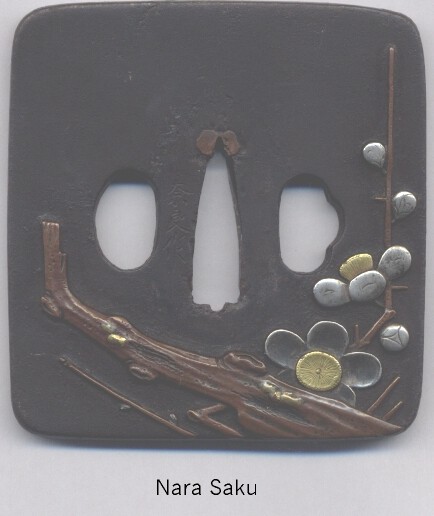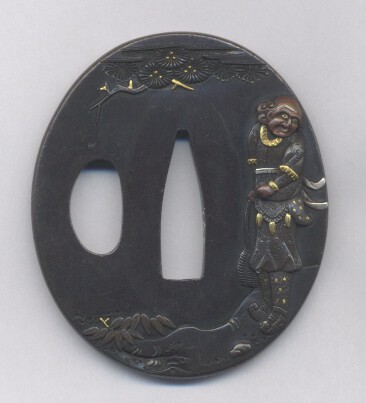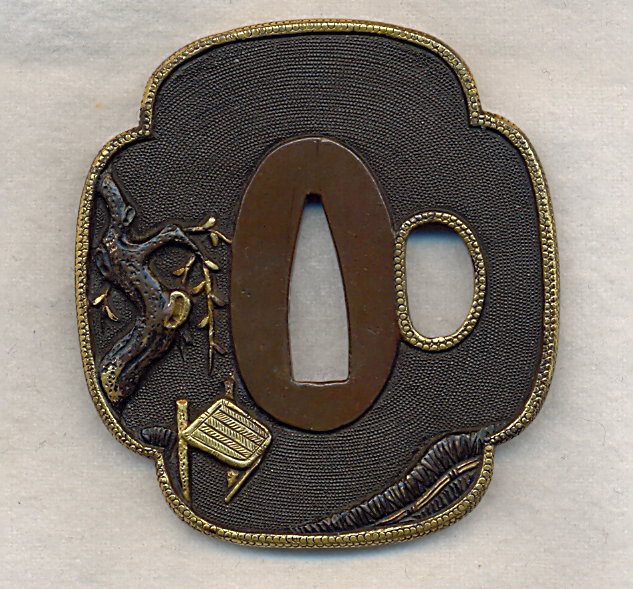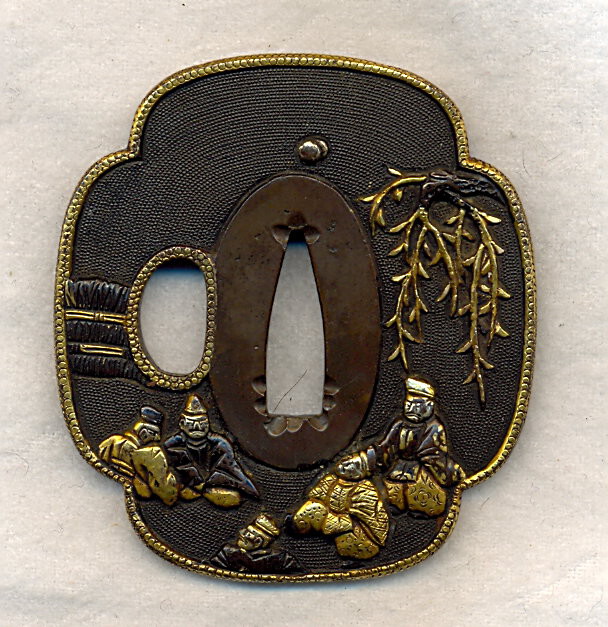
Clive Sinclaire
Members-
Posts
339 -
Joined
-
Last visited
Content Type
Profiles
Forums
Events
Store
Downloads
Gallery
Everything posted by Clive Sinclaire
-
Andrew Graham-Dixon's I, Samurai.
Clive Sinclaire replied to Ford Hallam's topic in General Nihonto Related Discussion
Strangely enough I had a drink with Victor only yesterday as he had just purchased a Gassan Sadayoshi katana in a London auction. He has been a close chum of mine and fellow kendo practitioner for several decades and I can assure you that he is a sincere and knowledgable individual with a very good understanding of Japanese swords, having been a pupil of Sato Kanzan in the 1970's. He also has a great appreciation of Japanese culture. His contribtion to sword preservation, whilst head of the Japanese Dept of the British Museum, should also not be underestimated. I know of no other museum (in the UK at least) which has had over 100 swords proffesionaly restored and polished in Japan. Do not be misled by this rather naive documentary which was made for a wider and less well-informed audience than may generally be encountered on this message board. Clive Sinclaire -
A really nice one !!
Clive Sinclaire replied to gudis's topic in Auctions and Online Sales or Sellers
Gentlemen For what it is worth, I have seen this very prominent jihada on shinshinto blades and on some early 20th century swords, before and I believe it is brought about by the use of mixed metals, although this piece looks well forged as well. Also I think that the use of mixed metals like this (the notes mention mixed metal was used) is considered a somewhat derogatory thing but is consistent with shinshinto trying to reproduce koto workmanship, it is just by using mixed metals they may have "cheated" a bit!. I notice also on the NBTHK Hozon paper that it was only recently at shinsa about a year ago. I guess it was probably polished at Bob Benson's studio. Regards Clive Sinclaire -
NBSK Craftsmen Competition results
Clive Sinclaire replied to Clive Sinclaire's topic in General Nihonto Related Discussion
Sorry, it didn't cut / paste quite right, see below for another attempt http://www.nbsk-jp.org/english/competit ... _2011.html Clive -
Gentlemen This is indeed an interesting thread with a number of differing opinions. My thoughts, for what they are worth. are that if one seriously collects and studies Japanese swords, one is exposed to what may be termed as "Japanese sword culture" and in many sad cases, such as my own and several other board members who I have had the pleasure of meeting, this becomes an important part of our lives. far removed from the "how much is it?" or "this sword speaks to me" school of thought. For me over the years, I have visited many countries because of sword events, made many friends and met with many interesting people. Of course, I have studied many fine swords including several National Treasure" blades and been a regular kendo and Iai-do practicioner as well as sampling much fine sake. I know some who have built Japanese style houses, others who have relocated to Japan and I myself have a tatami room which only contains swords and armour. The point I am labouring to make is that, sure you buy the books and collect whatever turns you on, but make sure you have a good teacher, see as many good swords as possible and allow yourself to be absorbed into Japanese sword culture for which this board gives a fine introduction. The long-term rewards for this are manifold. Sorry about this late night, silly old man diatribe. Clive Sinclaire
-
Suguha hamons - inferior / boring???
Clive Sinclaire replied to gtstcactus's topic in General Nihonto Related Discussion
Hi Jas I agree with most of the preceeding comments and as an appreciator of Hizen-to, it will come as no surprise to learn that I like good suguha very much. They present a clean and beautiful appearance on a well shaped blade and I was once told in Japan, that suguha are the hamon of the true conniseur! It is often said that they are generally the most efficient cutting edge, ie they are the sharpest. What's not to like ? Clive Sinclaire -
Hi Eric These are interesting and practical things I think. I have a similar signed Minamoto Nobukuni Kanetsugu which is mounted as a makura-yari. I understand that they were considered by the Kuroda clan, easily afixed to a new pole if the old one was broken in combat, unlike those with a nakago. Regards Clive Sinclaire
-
What is there to say, it is a genuine NCO sword. With these things the price is all about condition and whilst better than some I have seen, I would say it is in average to fair condition rather than pristine. Regards Clive Sinclaire Regard
-
Rob I think it is a zodiacal or constellation design Clive Sinclaire
-
Paul Of course you are correct - too much Royal Wedding TV has numbed me! Clive
-
I assume it is the same sword?? Clive
-
Gentlemen |f you go to http://www.To-ken.com under Sword Register No.76 you will see my crude oshigata and write up on this sword. Regards Clive
-
These are 2 of my favourites, the square iron one is signed Nara Saku. I think this may be a standard design for a certain Nara group as I have seen it elsewhere. The small shakudo tsuba is mumei and depicts a "Dutchman" I believe. I do have a good iron piece of 2 tsuru "suivant" which is signed Miochin Yoshihisa and I believe this is Echizen work. I will try to dig it out tomorrow. Clive Sinclaire
-
Gentlemen There is a meeting of To-ken Society of Great Britain this coming Thursday, 21st April in central London. The guest speaker is Mr John Man, author of a new offering entitled SAMURAI, The Last Warrior. This is mainly about Saigo Takamori, his life and times. Further details are available at http://www.To-ken.com under "Meetings". All are welcome and I will review the book soon. Regards Clive Sinclaire
-
There is a suprising degree of ignorance in many museums concerning Japanese swords as well as a reluctance to display them in many cases. Even such institutions as the British Museum, having had over 100 swords polished in Japan , currently have only 3 swords as part of as part of a general display. This is soley because Victor Harris has retired, but fortunately he still has influence and so swords may be viewed by appointment. I have been loudly and rudely told off by some young female conservator at a museum for handling a sword without gloves, which, as I am very strict on sword handling etiquette, and have handled National Treasure swords in Japan, I found deeply insulting. I do not believe that museums, outside of Japan, are suitable or deserving places to inherit collections and they are far better off in the hands of collectors who will cherish them. It is up to us to do everything in our power to educate these babarians even if it may seem an impossible task . I agree with Brian wholeheartedly! Clive Sinclaire
-
Gentlemen It may prove of some passing interest for me to tell about Engineer-Commander Alex R Newman who was an Honary Librarian of the Japan Society of London as well as an Honary Curator at the British Museum. As I said, it was from him that I acquired this "soccer tsuba". I met him in the early 1970's as he was a patron of various judo competitions in which I took part and he was 90 years old then. He would tell a tale of his youth, when he used to meet the boats as they came in from the Far East into the London docks. It was "customary" for the dockers, whilst unloading, to let the odd crate fall and break open on the dockside so that they could take a small bonus from the contents. Once, such an "accident", revealed what the dockers believed were "Chinese belt buckles" and they were not interested. It was on this day, that Newman started his tsuba collection! He had several hundred tsuba and I and my girlfriend (now wife) were invited to his house in Hampstead (an up-market suburb of north London) and he would let me buy several tsuba every time I visited. He had also written a book Japanese ART, A collector's Guide, which gave some decidedly unwise advice on tsuba restoration. He had a narrow but high L-shaped workshop and when I first went in it, I saw hanging on the wall amongst hammers, chisels and various other tools, a pristine iron 62-plate suji-bashi. On enquiring the reason for it being there, he said he wore it in case any of the other tools was to fall on his head! It turned out to be by Miochin Muneyoshi and dated 1851. After I had bought and sold it, I found it illustrated in The Manufacture of Armour and Helmets in 16th century Japan. Like I said I bought a number of pieces from him, most of which I still have. These include a round iron tsuba depicting a "monkey showman". that was restored after receiving bomb damage in the Blitz during World War 2. I was very sad that I was unable to buy more of his pieces before he died. He left the rest to the Ashmolean Museum in Oxford and there they remain in the vaults, never again seeing the light of day - what a crime and a shame on museum culture, when they could have been enjoyed by collectors. Some kind of lesson to us all, I guess. Regards Clive Sinclaire
-
I guess you might be correct but it is a very strange looking moon I think. The previous owner (I bought it in the 1970's) was Commander Alex Newman who was a curator at the British Museum and his catalogue notes say "five footballers under a willow". It was he who told me that it was a Heian period court game. By the way, it was originally bought at Glendennings auction in London in 1948. I attach the ura which I think, depicts the goal,. Regards Clive Sinclaire
-
Gentlemen I rather enjoyed the recent thread on "unusual subjects for menuki" and meant to show this there so please indulge me here. This tsuba shows courtiers playing football which apparently was a Heian period courtly game. The ball is above the seppa dai and a couple of the nobles are looking up at it. It is not a great quality tsuba but I have never seen the subject before. Regards Clive Sinclaire PS: Ford, I may not have told you this before, but I once won a prize from To-ken Shunju Press for designing a tsuba. It had to be a modern design that reflected the current age and I drew the classic wave at Kanegawa and put a surfer on it! Simple
-
Recieving a Katana as a gift and importing it into the US
Clive Sinclaire replied to Lokke's topic in Nihonto
Dear Locke I cannot comment on inport into the USA as I am a UK resident. However, I am aware that the export procedures from Japan are quite strict and involve the surrendering of the Torokusho or registration card. This applies to tanto as well as daito. If you have a koshirae made for the sword, whilst it is possible outside of Japan, I would suggest that there is a greater choice to be had in Japan. It is usual, if a sword is polished, that it is thereafter stored in shira-saya and a wooden blade, known as a tsunagi, is made for the koshirae to allow it to be displayed. Whilst you may be able to check-in the swords, I would expect this to be difficult and would think that mailing them is easier. I have exported many swords from Japan and these have are usually after they have been polished. In this case, either the polisher does all the necessary export paperwork or on occasions, an agent is employed, which ensures it is all done correctly. I see whilst I have been typing this some of your questions have already been answered and that I am duplicating this response so I will quit now. Regards Clive Sinclaire -
Hi Gary It reads GOSHU HIKONE JU (the 2nd pic) SOHEISHI NYODO SOTEN SEI (the 1st pic) and yes it is a Soten tsuba.This is the "standard" Soten inscription. Regards Clive Sinclaite
-
Gentlemen I am not really a tosugu man and so apologise if the following is considered an unnecessary or naive post as I am sure there is nothing new here but hopefully it will enhance my "anti-snob" credentials! Maybe, like Roger, its the Hizen "thing" but I quite like Soten tsuba myself and have 5 examples. These cost me from £25 to the most expensive (and recent buy), at £300 last year and I believe admirably demonstrate my lack of sophistication in this area (of which I am quite proud). Those already posted by Roger look good to me and I think that there can hardly be fakes of Hikonibori or Machibori, by definition. Machibori is only artisans copying other work is it not, and they should be accepted as such shouldn't they? I know that some Soten, unlike most which show Chinese figures or Gempei War scenes, are in shakudo-nanako rather than iron, and to my eye they resemble Mino-Goto workmanship - I would be grateful if anyone could explain this different style and what may be inferred from it? Saying that, I do know of a famous Soten tsuba by the first master I believe, which is absolutely fabulous and was even well known and illustrated in the Edo period. Unfortunately, theses "8 Views of Omi Province" are in a private collection in Japan and unbuyable. Actually, I am surprised that my friend Roger does not collect the 100 Horses or 100 Monkey tsuba by Mitsuhiro! Regards Clive Sinclaire
-
advice for novice on appraisal
Clive Sinclaire replied to intosight's topic in General Nihonto Related Discussion
It would be a spooky coincidence if it turned out to be SANJO YOSHINORI as I am just looking at a sword with this mei by a UK owner. Clive Sinclaire -
Tadakuni wakazashi with a cutting test
Clive Sinclaire replied to Jim P's topic in Auctions and Online Sales or Sellers
Hi Jim Having checked a few more references today, it is still not 100% clear if the shodai had the Harima no Kami title although there is some evidence to suggest that I may have been incorrect in my assertion that the shodai only had the Harima Daijo title. In HIZEN NO KATANA TO TSUBA there are several Tadakuni oshigata illustrated but no shodai are shown with the KAMI title, only later generations. In KANZAN's OSHIGATA, only 3 Tadakuni are illustrated and on one of these he notes it as "shodai Kami mei". Finally in SHINTO TAIKAN There are 10 shodai with the Daijo title and 4 shodai with the Kami title. Unfortunately my HIZEN-TO TAIKAN is out on lone at the moment. These certainly suggest that the nidai Hizen Tadakuni had the title, if we believe these sources (which are known not to be infallible). John, I presume you are quoting Gordon's translation of Eguchi's Hizento Hikkei but I found him a bit vague on this as there is no date mentioned, which is unlike him. (actually I met him once and we had a damn good chat and a few beers!) As for the workmanship, as we said before, the majority seem to be in Hizen type suguha but others show a predominantly Bizen style. Well it has been an nteresting discussion and I think I deserve this evening's beer: Regards Clive Sinclaire -
Tadakuni wakazashi with a cutting test
Clive Sinclaire replied to Jim P's topic in Auctions and Online Sales or Sellers
Hi Jim Like I said, there is some dispute about whether or not shodai Tadakuni had Harima no Kami title but your Tokubetsu Hozon certificate clearly states that this is a blade by shodai Tadakuni, so NBTHK obviously thinks that he did receive the title. However, this MAY still not be correct, although I see it was a very recent shinsa and I would not dare to try and say the NBTHK could possibly be mistaken!. However, Fujishiro, for instance in Shinto Jiten, only acknowledges nidai with Harima no Kami. I wonder if yours has been classified as shodai because it does not have a Kiku or Botan inscription on the nakago which are only seen on nidai,, as otherwisw the workmanship between the 2 generations is considered very similar? I also notice the machi-okuri on your sword, which may mean any Botan was removed, but I would have thought this to be highly unlikely. Altogether an interesting debate and I will check other Hizen references during the course of the day and see what they have to say. Thank you very much for showing the origami of your interesting orikaishi-mei Tadakuni katana. Regards Clive Sinclaire PS: The rabbit population of Kent remains in tact as I shot none. Those that I saw unfortunately presented awkward shots as I would have hit one of the dogs as well as a rabbit and most were too small anyway (2011 new models we call "bolters").





